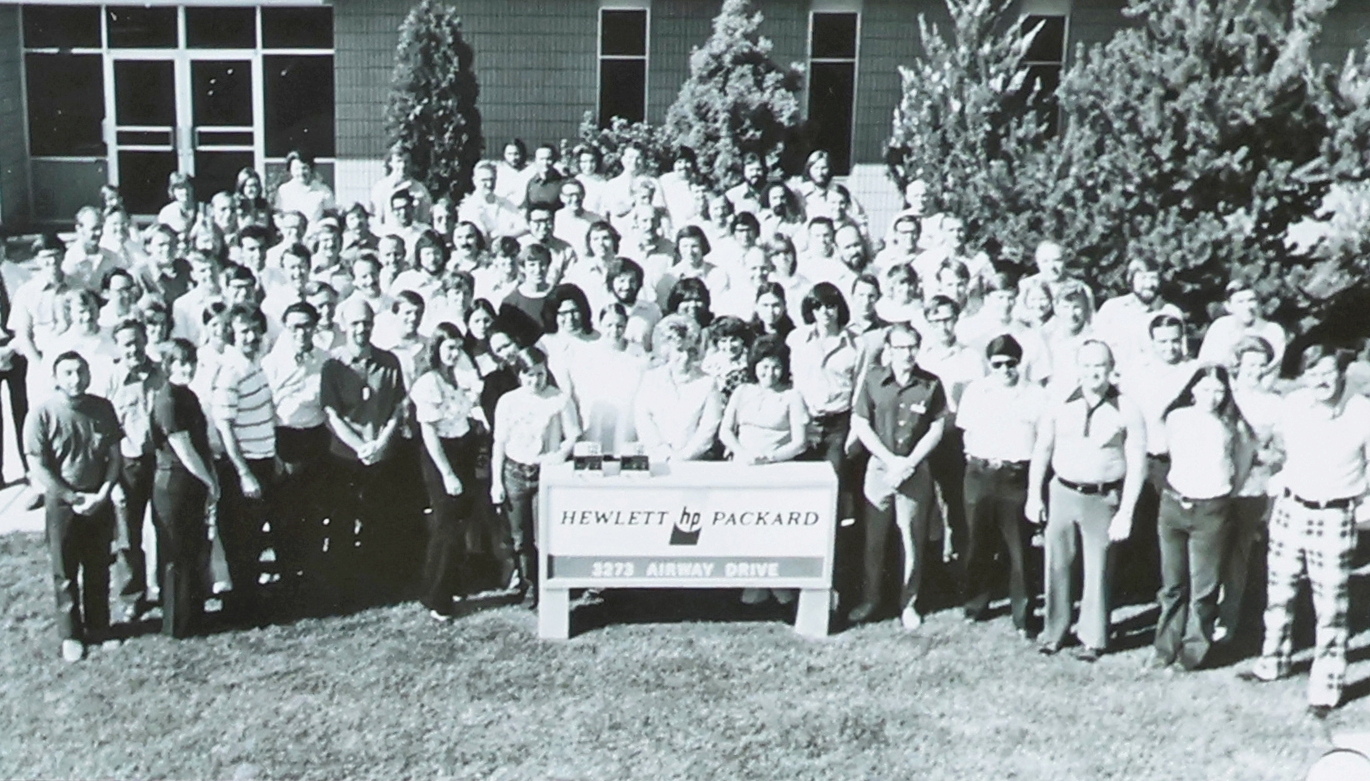HP Memories


ForewordThe History of Microwave Signals on Thin-Film on Sapphire In the Golden Years of Microwave Instrumentation of the last-half of the 20th century, Hewlett-Packard dominated that business sector. It can be argued that a new phase all started in 1964, when Packard sent Microwave Division (MWD) manager Bruce Wholey to manage HGP's new medical acquisition, Sanborn, near Boston. Then he appointed John Young take over the MWD, and Young assembled a new team, Paul Ely, John Doyle, and me, to take the emerging technologies and make history. Well, I'm pretty sure Packard would not have used that marching order. He would have expected that Young, who was barely out of Graduate Business School at Stanford, would not screw up HP's growth rate of 15% per year, doubling every 5 years. What John's division did was to grow at a 30% rate, tripling revenues in the same 5 year period. Of course it didn't hurt that President Kennedy's Space Race spending and the Cold War Vietnam War buildup, both microwave intensive, were in their big funding years. But more significantly, the MWD introduced two blockbuster product lines that were to revolutionize microwave measurements forever. First, in a serendipitous 1965 arrival, was the 2 GHz scan, HP 8551A Spectrum Analyzer, a brand new product sector for HP, which grew to become a $10 million dollar annual contributor. Several years later, in 1968, came the HP 8410A Network Analyzer family (Remember Ely's "Stamp out Slotted Lines.") which provided the engineering world with untold design and test insights to component development, with the re-emerging exploitation of the design power of SmithChart data on a CRT display. Some of us remembered actually plotting SmithChart data, point by point, from slotted line measurements. All those magnificent yearly business accomplishments happened upon the whole line of product design components from WWII antiquity. Microwave sources were clunky Klystrons with 1000 volt power supplies, and tricky cavity tuning. Backward Wave Oscillators needed huge magnets and sweeping 2000 volt power. Inside those instruments were a mixture of individual components; filters, switches, directional couplers, amplifiers, multipliers, step-attenuators, down-converters, mixers, and mechanical tunable cavities. And all these needed to be connected with a rats-nest of BNC and 3.5 mm signal cables, which greatly impacted operating functions, not to say, reliability. Breakthrough. But there was design ferment emerging from the industrial semiconductor technology, of Fairchild and Texas Instruments and others, pushing into silicon micro-circuits and vast miniaturization of circuit functions. Those functions were increasing in frequency, into the microwave domain. GaAs semiconductor chips now made amplifiers, YIG-tuned oscillators were 1/20th (a guess) the size of the BWO of yore. It now became possible to dream of a whole "block-diagram" miniaturization of microwave functions. And somewhere in Ely's labs were peope dreaming of a microwave printed-circuit board working at X-band. With chips and Thin-Film traces, say, deposited on low-loss sapphire substrates, which could integrate and improve all those functions without inter-connecting cables of 4 inches. To me, the story of this magnificent technology leap comes from the memories of the Santa Rosa Tech Center 50th Year Reunion attendees. Micro-miniaturization of microwave functions on sapphire started in Palo Alto, some years before the construction of the Santa Rosa facility and move-out in the early 1970s. Bringing semiconductor industrial practices to the MWD involved more than clean rooms and wire-bonding and chemistry. The team needed to integrate the power of the emerging network analysis diagnostics into all of the new circuit functions that needed to be reduced to gold traces on sapphire. Just imagine the creativity of filters in gold trace, couplers and amplifiers and mixers, entire down-converters, and much more. The variety of microcircuit functions is well represented by this HPMemoir photo gallery of teams. I'll just list them for impact. Diodes, Bipolar & FETs, GaAs ICs, SAWs, YIGs. Now combine these elements with thin-film and sub-systems, and get filters and amplifiers and couplers and mixers, all next each other, no cables. Next, YIG-tuned multipliers, for microwave sources up to the millimeter K-Bands, and dual-down-converters (HP8410A), and more I can't think of. And now, out of some correspondence regarding the Reunion personnel, comes a photo and commentary from 1966, reminding of Pat Wang's role of the time. The statement revealed that Pat was using a chemical processing setup, literally in a Page Mill closet sized compartment, for early thin film parts. Moreover, in a surprise to me, it stated that Art Fong was running the Thin Film Project. And that makes sense, because Art had just rolled out the blockbuster HP8551A Spectrum Analyzer in 1965, so this was his next assignment. One subset of the attendees at the Reunion is the Team photo of the employees who came from the Palo Alto Tech Labs, I don't think it was yet dubbed Tech Center? Missing is my memory of George Bodway, Mr. MW Microcircuit. I recall his impressive life story of a PhD candidate putting himself through school by laying carpet for several years. What a community of kindred spirits with a grand goal of greatness in invention. Paul Ely used to brag that he didn't prefer to hire personalities that were too much academics, but instead to focus on hiring inventors. I assert that it was inventors that had the creativity that met together after 50 years. For those early 1970s years, I was personally on a side-track from my Microwave interests, 3 years building light emitting digits, and 2 years Automatic Test System, before returning to my life's work at the renamed Stanford Park Div, in 1974. By that time the elegant Santa Rosa Tech Center was in full bloom, gleaming facilities, with integrated instrumentation for in-process and continuous diagnostic quality control of that microscopic world of processes which dazzled the imagination. And everywhere, the mind blowing image of conciseness in component packages of gold plated modules, signifying top quality, reliability and long life. Like HP's decades-long commitment to gold-plating the traces of our ordinary production printed circuit boards, admired by customers. I will end by noting that it is not an exaggeration to proclaim that the Tech Center achievements in microwave miniaturization truly rivals those of other industrial giants like Intel, in those same years of breathtaking digital microprocessors. There is a postscript to this story that fits the Bill Hewlett theorem, "If you don't have 10 to 20% project failures, you aren't stretching enough on pushing technology." In the 1960s, media communication developers had attempted to take TV to a wider public with cable distribution. But viewers were resistant to the notion of paying for something they could get for free over the air. By the 1970s, however, cable distribution was able to deliver new programming services that were unavailable from network TV. The buildout of cable distribution opened mass markets for the CATV line amplifiers. HP saw that bidding for high volume contracts would enable mass-production equipment improvements and sharing overhead for the thin film production depts. Sadly, the CATV frequency bands were easily done with regular cheap PC boards, automatically assembled. We may have only landed one contract, and memory says we didn't compete future bids. And finally, my hobby since my wife died in 2016, is to award my "Noble Prizes," the Ten AttaBoys certificate to people whose actions charm me. I believe that the Tech Center Team qualifies for a Noble, and the award will be attached herewith to this HPMemoir. John Minck |

Click the picture for a higher resolution version
HP MemoriesThis memory of the Microwave Tech Center at hp results from the work of the www.hpmemoryproject.org website of Marc Mislanghe, who with John Minck edited and published the original archive of Memoirs. After Marc's untimely death in 2014, Ken Kuhn has now assumed the custodianship with John, and together they will continue to expand the Memoirs section. One of the main objectives in starting this website in 2011 was (and still is today) to get in touch with people who have worked at hp from the birth of the company up to today. We are interested in hearing your memories no matter what division or country you worked in, or whether you were in engineering, marketing, finance, administration, or worked in a factory. This is because all of you have contributed to the story of this unique and successful enterprise. Your memories are treasure for this website. While product and technology are our main concern, other writings related to the company life are highly welcome, as far as they stay inside the hp Way guidelines. Anybody Else? Please get in touch by emailing the webmaster on the Contact US link at http://www.hpmemoryproject.org |